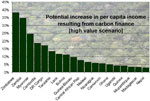Tetepare may be one of the last tropical island paradises left on earth. Headhunting and a mysterious illness drove its original inhabitants from the island two hundred years ago, making Tetepare today the largest uninhabited island in the tropical Pacific. The 120 square kilometer island (46 square miles), long untouched by industry or agriculture, is currently threatened by logging interests. However, the island is not without champions: in 2002 descendents of the original inhabitants of Tetepare formed the Tetepare Descendents Association (TDA) to preserve the island. Recently they have teamed up with the Solomon Islands Government and the Solomon Islands Community Conservation Partnership to develop financing through REDD.
“Since 1998, our island has been under extreme logging pressure from foreign interests,” says Allan Bero, Program Coordinator of TDA and descendant of Tetepare Island. “We formed our 3,000-plus member landowner association, TDA, to combat this pressure and it’s working. We are preserving our land and culture, while improving the quality of life of our families.”
A legally binding conservation agreement, which mandates the protection of Tetepare’s forests, upholds the TDA constitution.
“Communities committed [to TDA] because they saw the benefits of keeping their heritage intact, we also knew this would hold opportunities for the future,” Bero explained. “And now, if we can access REDD markets, the descendants of Tetepare will realize the benefit of our commitment to conserve our homeland.”
Locals believe that if Tetepare succeeds in REDD financing it could provide a model for protecting other threatened forests among the islands. Working with the Solomon Islands Government, the project will allow government officials and members of TDA to receive training on forest carbon assessments, building capacity for future projects in the region.
“As an island nation, we believe a REDD project for Tetepare is our hope that global responses to the climate crisis can impact the lives of local people whose traditional lands hold great hope for the future of all people,” adds Tetepare descendent and Minister for Environment, Conservation and Meteorology Gordon Darcy Lilo.
Tetepare is home to a number of notable species, including birds such as the beach stone curlew, crested cuckoo-dove, Kolombangara monarch, the endemic Tetepare White-eye, and the Sanford’s sea eagle classified as Vulnerable by the IUCN Red List. Reptiles include the saltwater crocodile, Solomon Islands skink, the mangrove monitor, and the Pacific ground boa. Although home to wild pigs—which are hunted from time-to-time by people on neighboring islands, the majority of mammals on the island are bats and cuscus species.
To date researchers have documented a total of 73 bird species, 24 reptiles, four frogs and 13 mammal species.
The reef systems around Tetepare support some of the richest marine life in the world. Three species of highly endangered marine turtle use the untouched beaches to lay their eggs: the green, the hawksbill, and the world’s largest, the leatherback. Dugong, considered Vulnerable, swim along the shores.
To see photos of Tetepare: http://www.tetepare.org/Gallery%20images/index.htm
For more informaion on Tetepare: http://www.tetepare.org or the Center for Biodiversity and Conservation: Tetepare REDD
Video of the Tetepare project.
Related articles
Six nations pledge to protect the Coral Triangle
(05/19/2009) Last Friday, six nations signed a pledge launching the Coral Triangle Initiative on Coral Reefs, Fisheries and Food Security (CTI-CFF). Indonesia, the Philippines, Timor Leste, Papua New Guinea, Solomon Islands, and Malaysia each agreed to protect the Coral Triangle, a region spanning 1.6 billion acres, half the size of the US.
New bird species discovered in the South Pacific
(04/19/2007) University of Florida scientists have discovered a new genus of frogmouth bird in the Solomon Islands. The findings are published in the April edition of Ibis: The International Journal of Avian Science.
Avoided deforestation could send $38 billion to third world under global warming pact

(11/01/2006) Avoided deforestation will be a hot point of discussion at next week’s climate meeting in Nairobi, Kenya. Already a coalition of 15 rainforest nations have proposed a plan whereby industrialized nations would pay them to protect their forests to offset greenhouse gas emissions. Meanwhile, last month Brazil — which has the world’s largest extent of tropical rainforests and the world’s highest rate of forest loss — said it promote a similar initiative at the talks. At stake: potentially billions of dollars for developing countries. When trees are cut greenhouse gases are released into the atmosphere — roughly 20 percent of annual emissions of such heat-trapping gases result from deforestation and forest degradation. Avoided deforestation is the concept where countries are paid to prevent deforestation that would otherwise occur. Policymakers and environmentalists alike find the idea attractive because it could help fight climate change at a low cost while improving living standards for some of the world’s poorest people and preserving biodiversity and other ecosystem services. A number of prominent conservation biologists and development agencies including the World Bank and the U.N. have already endorsed the idea.